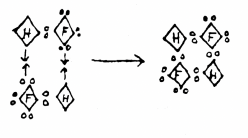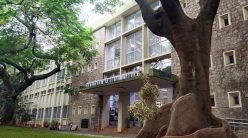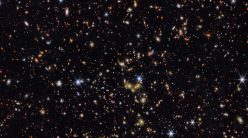Looking back at over 100 years of its publication

I once asked the students at one of my lectures whether they had heard of the Journal of the Indian Institute of Science. The response I received was depressing, particularly because I happened to be the Journal’s Editor at the time. Except for a few hands that hesitatingly went up in a class of over 70 students, it was clear that none had had a look at the Journal. I soon found out that many faculty members too were unaware of the Journal’s existence, even though it has a citation index that is respectable among current Indian journals and is also on Web of Science with an impact factor of 1.8.
The Journal of the Indian Institute of Science is today a review journal, a one-of-its-kind in India. An enthusiastic editorial board with GK Ananthasuresh (Professor of Mechanical Engineering at IISc) at the helm is actively pursuing its publication activities and I am informed that the articles for the next couple of years of the Journal (Volumes 100 and 101) are already lined up.
But the Journal had a very different avatar when it began 105 years ago. When IISc was established over a century ago, its Council felt that the Institute should publish its own journal. In fact, at its meeting on 19 January 1914, the Council sanctioned an initial grant of Rs 1,000 (a very generous amount in those days!) to start the Journal, with a mandate to publish “scientific and technical” articles. The first set of 10 articles initially submitted to the Council cost 403 rupees, 13 annas and 3 paise to print. The first volume of the Journal containing 21 articles was published during the years 1914-1918. The first article in this volume, entitled “Borohydrates” was authored by Morris W Travers (the first Director of IISc), Rames Chandra Roy and Nalini Mohan Gupta. Volume 2, published over the next three years, contained 15 papers; volumes 3 and 4 contained 9 and 16 articles, respectively. Since 1922, each year saw the publication of a single volume. In the early years of the Journal, the Director of the Institute served as the Chairman of its editorial board. Given IISc’s British connections, they adopted the policies of the Royal Society’s journals, with Section A of the Journal dedicated to chemistry and Section B meant for electrical engineering, as these were the two departments with which the Institute began functioning.
Researchers of our Institute felt that publishing in journals already established elsewhere would bring them more recognition
The Bangalore Press was involved in the Journal’s publication during the 1930s and ’40s, and the Institute’s library was in charge of it from 1951 to 2007. In 1971, GN Ramachandran became the Journal’s Editor with TKS Iyengar, the Institute’s Librarian, as the Associate Editor. In 1974, Iyengar was appointed as the Executive Editor. Subsequently, several eminent researchers from the Institute donned the mantle of the Editor – N Mukunda, S Soundaranayagam, M Vijayan, SS Krishnamurthy and MS Shaila – while librarians NM Malwad and S Venkadesan served as Executive Editors. I must note here the contributions of K Srinivasa Rao, who served as an Assistant Editor for several years, doing literally everything from copyediting to producing the final print form of all the articles.
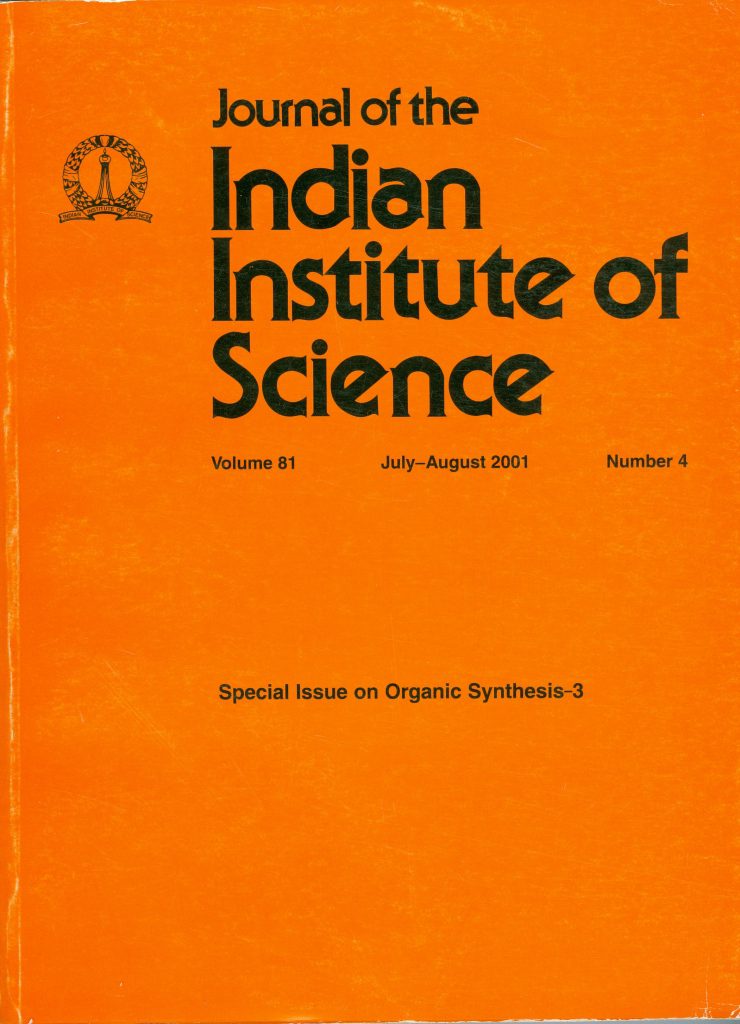
In this period, the Journal started including synopses of the PhD theses submitted by the students to the Institute and these turned out to be the major content of the volumes published. The Journal lost its identity as a consequence and went through a lean “yellow” period (yellow being the colour of the cover page during this time). During 1978-1992, the Journal went through many changes based on suggestions from the Director and the editorial board members. It became a monthly journal and, starting from 1978, each issue had a theme. In 1992, the Journal became a bi-monthly.
In 2003, LM Patnaik, then a professor in the Department of Computer Science and Automation, took over as the Editor, and he formed a new editorial board which apart from publishing the Journal online stopped publishing thesis synopses and made fresh efforts towards publishing peer-reviewed articles from the members of the Institute. I had the privilege of serving as a member of this editorial board and, with enormous efforts, we managed to publish a reasonable number of articles from the Institute faculty. The cover design as well as the layout of the Journal were redone, and the quality of the printing improved, too. However, very soon the initial excitement from the Institute’s faculty diminished and it became very hard to get a sufficient number of papers to keep the quarterly publication of the Journal going.
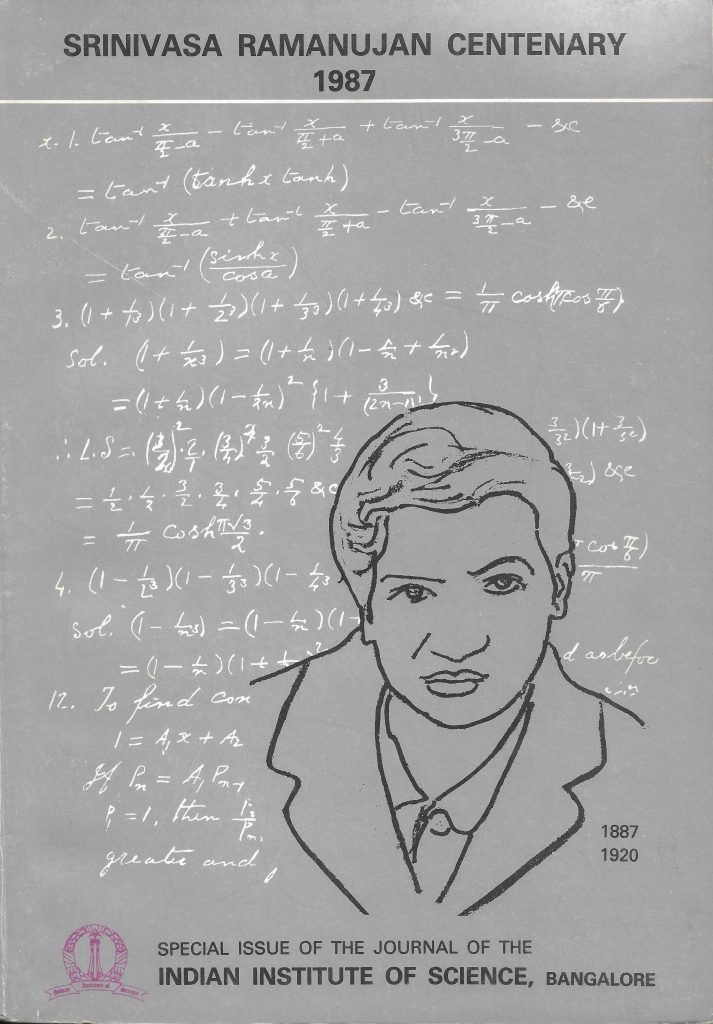
Cover page of the Journal’s special issue commemorating Srinivasa Ramanujan’s birth centenary in 1987 (Image: IISc Archives)
At this juncture, in 2007, P Balaram, the then Director of the Institute, called a meeting of the editorial board and, after detailed discussions, suggested closing down the Journal. Even though Patnaik was to retire that year, the editorial board members were reluctant to stop a nearly 100-year-old journal. After several hours of deliberation, Balaram came up with the idea of remaking the Journal into its current avatar of a review journal. Such a review journal serves the important purpose of publishing reviews of selected research areas in a way accessible to researchers from different disciplines. A useful feature of these review articles are short explanatory notes, appearing in the margins, of terms that might be widely known to researchers within a particular field but not to those in other fields. The authors of review articles use their judgment to identify such terms and provide short explanations.
In 2008, a new committee was set up with myself as the Editor, and the Journal was moved to the Archives Cell, which was renamed the Archives and Publications Cell (now the Office of Communications). IIScPress was established as an entity within the Archives and Publications Cell, bringing all the Institute’s publications under a single umbrella. In these changes, the efforts of AG Menon, the first Chair of the Archives and Publications Cell, were very helpful. After Srinivasa Rao’s retirement, Kavitha Harish has been handling the publishing of the Journal as its Editorial Assistant since 2008.
Over the years, there have been a few special issues of the Journal published to commemorate important occasions. Thus, a special issue was published during the Golden Jubilee year of the Institute in 1959; one to commemorate the birth centenary of the mathematician Srinivasa Ramanujan in 1987 which carried, among other things, handwritten content from Ramanujan’s notebook put together by KG Ramanathan; and one in 1988 to commemorate the birth centenary of CV Raman.
A special issue of the Journal commemorated the Institute’s centenary year in 2009. It carried 100 landmark papers published by IISc researchers over the years in various other journals. In 2014, another special issue commemorated the centenary of the Journal, carrying selected original papers published in it over its first fifty years, from 1914 to 1964. These papers were selected for their historical as well as current scientific value.
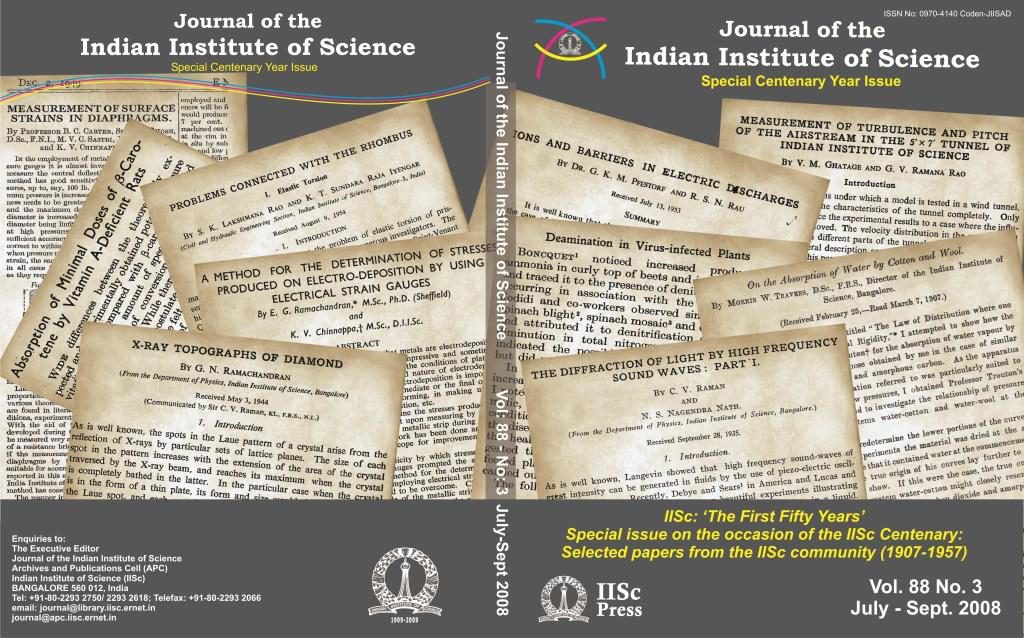
Starting from 2017, the Journal entered a co-publishing arrangement with SpringerNature for an initial period of three years, facilitating its greater global reach. A new committee headed by GK Ananthasuresh as the Editor was set up in 2018 and, for the first time in the history of the Journal, its editorial board has members from outside the Institute. In 2020, the 100th volume of the Journal will be published, with the first issue on hydrogen bonding, being guest edited by E Arunan of the Department of Inorganic and Physical Chemistry. This is a fortunate coincidence, for 2020 will also mark 100 years of hydrogen bonding. May the Journal continue to be published for the next 100 years!
With inputs from Kavitha Harish
TN Guru Row is an Honorary Professor at the Solid State and Structural Chemistry Unit, and was the Editor of the Journal of the Indian Institute of Science from 2008 to 2018


